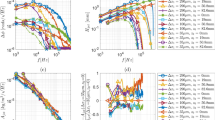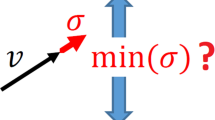Abstract
The dual cylindrical wave system is a variant of laser Doppler velocimetry, in which two cylindrical waves of laser light are used to illuminate a moving particle. This instrument is being used for local measurement of the unsteady skin friction in turbulent boundary layers, as well as droplet sizing in spray flows. In the present work, performance of these new devices is examined using the electromagnetic theory of light. Various requirements for the design and operation of these instruments have been further elaborated and extended. The accuracy of the previous experimental results has also been considered. The optics-related errors are shown to be negligible in the measurements of streamwise as well as spanwise wall velocity gradients. However, rigorous simulations appear to be essential for proper calibration of the particle sizing device.
Similar content being viewed by others

Abbreviations
- A, B, C :
-
three particle positions
- a :
-
half-width of an optical slit
- a gm :
-
amplitude of a plane wave in the spectrum of a cylindrical wave
- d f :
-
fringe spacing
- d p :
-
particle diameter
- E :
-
amplitude of the electric oscillation in the optical field
- E c :
-
combined electric field of two cylindrical waves
- E o :
-
maximum strength of the electric field at the source of a cylindrical wave
- E s :
-
electric field of a scattered wave
- E y :
-
time-dependent electric field in the case of electric polarization
- f :
-
characteristic length for the phase of the scattering amplitude
- f a :
-
anisotropic frequency
- f D :
-
Doppler frequency
- F DCW :
-
transfer function of DCW system for particle sizing
- F pDA :
-
Phase Doppler transfer function
- g :
-
wall velocity gradient
- g m :
-
measured wall velocity gradient
- I 0, I2 :
-
integrals in the asymptotic expansion of the scattering amplitude
- I s :
-
intensity of the scattered light
- k :
-
wave number of laser light in the fluid medium
- m :
-
refractive index of the particle relative to the surrounding medium
- N 0 :
-
nominal number of fringes resulting from interference of two cylindrical waves
- P :
-
phase of a plane wave
- P 1, P2 :
-
phases of plane waves from downstream and upstream cylindrical waves respectively
- P s :
-
scattered light power at a receiving aperture
- r :
-
unit vector in the direction of light scattering
- r D :
-
distance of the signal detector from the particle center
- S :
-
scattering amplitude of a cylindrical wave
- S 1, S2 :
-
Scattering amplitudes of the cylindrical waves emanating from S1 and S2 respectively
- \(\vec S\) :
-
magnitude of the scattering amplitude for a plane wave
- S c :
-
combined scattering amplitude of two cylindrical waves
- S1, S2 :
-
downstream and upstream sources of cylindrical waves, respectively
- S μ :
-
scattering amplitude of a plane wave
- s :
-
half-spacing between sources of the cylindrical waves
- t :
-
time
- u :
-
velocity along x-axis
- w 0 :
-
1/e half-width of the field distribution at the waist of a laser sheet
- X 0 :
-
nominal width of the fringe volume along the particle path
- X :
-
particle position in the measuring volume
- x, y, z :
-
Cartesian coordinates
- α:
-
angle of the direction of wave propagation from x-axis
- γ:
-
coefficient of the second-order term in the phase function of a cylindrical wave
- δ:
-
angular size of the signal receiving aperture
- Δμ:
-
incremental μ used for numerical differentiation ɛ the ratio of Δμ to μ p
- ζ μ — μ0 :
-
integration parameter for I0 and I2
- θ:
-
half-angle between the directions of propagation of two waves
- λ:
-
wavelength of laser in the fluid medium
- λ0 :
-
wavelength of laser in vacuum
- μ:
-
parameter defining the direction of propagation of a plane wave
- μ1/e :
-
1/e half-width of the function A μ
- μ0 :
-
direction of propagation of the dominant plane wave in the spectrum
- μ0s :
-
the direction of propagation of the plane wave that contributes predominantly to scattering in a particular direction
- μ p :
-
the value of μ. corresponding to one cycle of P
- μ s :
-
change in μ corresponding to a lobe of the scattering amplitude
- μ :
-
a dimensional form of μ that determines lobes in the scattered field
- Φ:
-
signal phase, Φ0 + Φa
- Φa :
-
anisotropic phase shift
- Φ0 :
-
phase difference between two indicent waves
- φ:
-
off-axis angle
- ψ:
-
elevation angle
- ω:
-
circular frequency of laser light
References
Bohren, C. F.; Huffman, D. R. 1983: Absorption and scattering of light by small particles. New York: Wiley
Born, M.; Wolf, E. 1980: Principles of optics (6th ed.). New York: MacMillan
Cheng, R. K.; Popovich, M. M.; Robben, F.; Weinberg, F. J. 1980: Associating particle tracking with laser fringe anemometry. J. Phys. E 13, 315–322
Chew, H.; Wang, D.; Kerker, M. 1979: Elastic scattering of evanescent electromagnetic waves. Appl. Opt. 18, 2679–2687
Durst, F.; Müller, R.; Naqwi, A. 1990: Measurement accuracy of semiconductor LDA systems. Exp. Fluids 10, 125–137
Gréhan, G.; Gouesbet, G.; Naqwi, A.; Durst, F. 1991: Evaluation of phase Doppler system using generalized Lorenz-Mie theory. Proc. Multiphase Flows 1991, Tsukuba, Jap., pp. 291–294
Mie, G. 1908: Beiträge zur Optik trüber Medien, speziell kolloider Metallösungen. Ann. Phys. 25, 377–445
Naqwi, A.; Durst, F. 1992: Analysis of the laser light scattering interferometric devices for the in-line diagnostics of moving particles. Appl. Opt. (in print)
Naqwi, A.; Reynolds, W. C. 1991: Measurement of turbulent wall velocity gradients using cylindrical waves of laser light. Exp. Fluids 10, 257–266
Naqwi, A.; Reynolds, W. C.; Carr, L. W. 1986: Dual cylindrical wave laser Doppler method for measurement of wall shear stress. In: Laser anemometry in fluid mechanics — II (eds. Adrian, Durro, Durst, Mishina, Whitelaw), pp. 105–122. Lisbon: LADOAN-Instituto Superior Técnico
Naqwi, A.; Liu, X.; Durst, F. 1990: Dual-cylindrical wave method for particle sizing. Part. Part. Syst. Charact. 7, 45–53
Naqwi, A.; Durst, F.; Liu, X. 1991: Extended phase Doppler system for characterization of multiphase flows. Part. Part. Syst. Charact. 8, 16–22
Naqwi, A.; Liu, X.; Durst, F. 1992: Evaluation of dual-cylindrical wave laser technique for sizing of liquid droplets. Part. Part. Syst. Charact. 9, 44–51
Nayfeh, A. H. 1973: Perturbation methods. New York: Wilcy
Popovich, M. M.; Weinberg, F. J. 1983: Laser optical methods for the study of very large phase objects. Exp. Fluids 1, 169 178
Author information
Authors and Affiliations
Rights and permissions
About this article
Cite this article
Naqwi, A.A. Performance prediction of dual cylindrical wave laser devices for flow measurements. Experiments in Fluids 14, 121–132 (1993). https://doi.org/10.1007/BF00196995
Received:
Issue Date:
DOI: https://doi.org/10.1007/BF00196995



